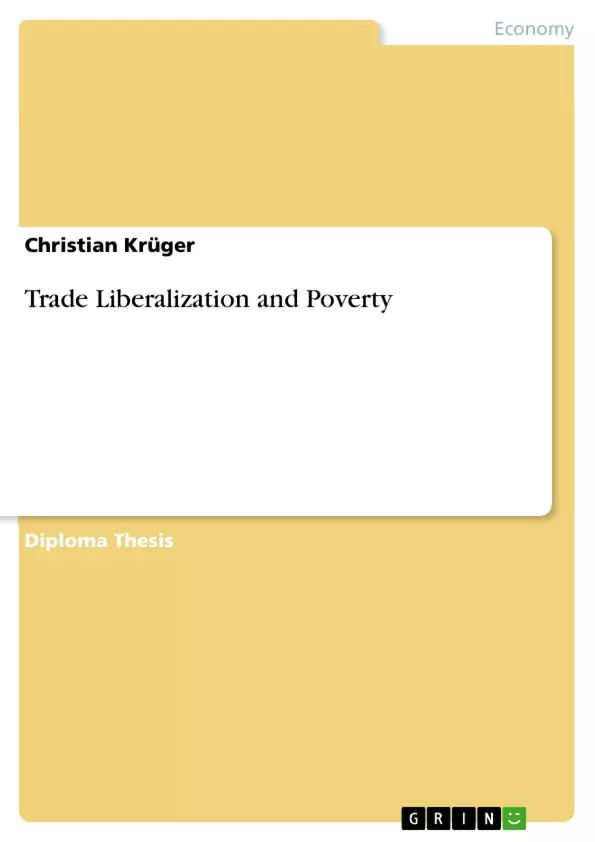After the successful experience of newly industrializing countries in East Asia (e.g., the East Asian Tigers: Hong Kong, Singapore, South Korea, and Taiwan) in the 1960s and Southeast Asia (e.g., the Southeast Asian Little-Tigers: Indonesia, Malaysia, the Philippines, and Thailand) by the late 1970s, trade liberalization (TL) in less developed countries (LDCs) has been considered as a policy to achieve rapid economic development. The argu-ment, put forward for instance by Dollar et al. [2002, p.195], that ―TL is good for [economic] growth‖ and that ―[economic] growth, [in turn], is good for the poor‖ has since served as the departure point for the discussion of the link between TL and poverty among economists, researchers, and policymakers alike.
Spurred on by the dramatic failure of import substitution industrialization (ISI) strategies, and with the advice and support from international financial institutions (IFIs), such as the World Bank, the International Monetary Fund (IMF) and the World Trade Organization (WTO), Krueger [1998, p.1521], for instance, finds that the intervening period has seen a large wave of TL episodes in countries in Latin America, Middle- and North Africa, Sub-Saharan Africa, and South Asia respectively. Believing that TL is vital for economic growth and poverty alleviation, these nations have frequently and extensively used it as a centerpiece for their development strategy. Howev-er, the high expectations held at the times those countries embarked on their trade policy reforms (TPRs) have not always been fulfilled in retrospect.
Inhaltsverzeichnis (Table of Contents)
- 1-INTRODUCTION
- 1.1 MOTIVATION
- 1.2 OUTLINE OF THE PAPER
- 2-DEFINITION AND MEASUREMENT
- 2.1 TRADE LIBERALIZATION
- 2.1.1 DEFINITION
- 2.1.2 MEASUREMENT
- 2.2 POVERTY
- 2.2.1 DEFINITION
- 2.2.2 MEASUREMENT
- 2.1 TRADE LIBERALIZATION
- 3 REASONS FOR TRADE POLICY REFORMS
- 3.1 ECONOMIC CRISIS
- 3.2 STRUCTURAL ADJUSTMENT PROGRAMS
- 3.3 THEORY AND RESEARCH
- 4-EXPERIENCES WITH TRADE POLICY REFORMS
- 4.1 VIETNAM
- 4.2 SOUTH AFRICA
- 4.3 KENYA
- 5-TRADE LIBERALIZATION AND POVERTY
- 5.1 ECONOMIC GROWTH AND POVERTY
- 5.1.1 ECONOMIC GROWTH
- 5.1.1.1 Theoretical Linkages
- 5.1.1.2 Empirical Evidence
- 5.1.2 POVERTY
- 5.1.1 ECONOMIC GROWTH
- 5.2 PRODUCTIVITY AND VOLATILITY
- 5.2.1 PRODUCTIVITY
- 5.2.1.1 Theoretical Linkages
- 5.2.1.2 Empirical Evidence
- 5.2.2 MACROECONOMIC VOLATILITY
- 5.2.2.1 Theoretical Linkages
- 5.2.2.2 Empirical Evidence
- 5.2.1 PRODUCTIVITY
- 5.3 PRICES AND MARKETS
- 5.3.1 PRICES
- 5.3.1.1 Theoretical Linkages
- 5.3.1.2 Empirical Evidence
- 5.3.2 MARKETS
- 5.3.1 PRICES
- 5.4 WAGES AND EMPLOYMENT
- 5.4.1 WAGES AND EMPLOYMENT
- 5.4.1.1 Theoretical Linkages
- 5.4.1.2 Empirical Evidence
- 5.4.2 TRANSITIONAL UNEMPLOYMENT
- 5.4.1 WAGES AND EMPLOYMENT
- 5.5 GOVERNMENT REVENUE AND SOCIAL SPENDING
- 5.5.1 GOVERNMENT REVENUE
- 5.5.1.1 Theoretical Linkages
- 5.5.1.2 Empirical Evidence
- 5.5.2 SOCIAL SPENDING
- 5.5.1 GOVERNMENT REVENUE
- 5.1 ECONOMIC GROWTH AND POVERTY
- 6-CONCLUSION
Zielsetzung und Themenschwerpunkte (Objectives and Key Themes)
This paper aims to provide a comprehensive overview of the complex relationship between trade liberalization (TL) and poverty, focusing on its potential impact on less developed countries (LDCs). It examines the arguments for and against TL, and analyzes the experiences of various countries that have undertaken trade policy reforms (TPRs).
- The influence of TL on economic growth and poverty alleviation.
- The role of productivity and macroeconomic volatility in the TL-poverty nexus.
- The impact of TL on prices, markets, wages, and employment.
- The implications of TL for government revenue and social spending in developing nations.
- The potential benefits and drawbacks of TL for different segments of the population, particularly the poor.
Zusammenfassung der Kapitel (Chapter Summaries)
The paper begins by defining and measuring both TL and poverty, providing a foundation for the subsequent analysis. It then explores the reasons behind trade policy reforms, particularly in the context of economic crises and structural adjustment programs. This is followed by an examination of the experiences of Vietnam, South Africa, and Kenya in implementing TL. The core of the paper delves into the intricate relationship between TL and poverty, examining the impact of TL on economic growth, productivity, macroeconomic volatility, prices and markets, wages and employment, and government revenue and social spending. The paper utilizes theoretical frameworks and empirical evidence to shed light on the various transmission mechanisms through which TL can affect poverty levels. It also acknowledges the complexities and uncertainties surrounding the issue, particularly in the short to medium term.
Schlüsselwörter (Keywords)
The study revolves around the key concepts of trade liberalization, poverty, economic growth, productivity, macroeconomic volatility, prices, markets, wages, employment, government revenue, and social spending. It also examines the experiences of specific countries like Vietnam, South Africa, and Kenya, drawing on theoretical linkages and empirical evidence to assess the impact of TL on poverty in developing nations.
- Citation du texte
- Christian Krüger (Auteur), 2010, Trade Liberalization and Poverty, Munich, GRIN Verlag, https://www.grin.com/document/153949



